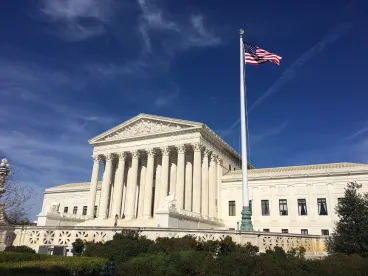Greetings, Court Fans!
After the avalanche of opinions last week, The Nine gave us a break with just one new decision to report this week. In Kansas v. Garcia (No. 17-834), a five-justice majority upheld the state-law identity-theft convictions of three noncitizens who fraudulently used another person’s Social Security number on their employment authorization forms. Read on for more on that case, as well as three stragglers from last week: Intel Corp. Investment Policy Committee v. Sulyma (No. 18-1116), on the knowledge requirement for fiduciary-breach claims under ERISA; Shular v. United States (No. 17-6662), on the definition of “serious drug offense” under the Armed Career Criminal Act; and Holguin-Hernandez v. United States (No. 18-7739), on the specificity of objections needed to preserve challenges to the length of a criminal sentence.
At issue in Kansas v. Garcia was the interplay between state and federal law concerning work-authorization for immigrants. The Immigration Reform and Control Act of 1986 makes it unlawful to hire an alien knowing that he or she is unauthorized to work in the United States. The statute requires employers to comply with a federal employment verification system and concomitantly requires all employees to complete a Form I-9 (which requires information including a Social Security number) by their first day of employment to attest that they are authorized to work. It is a federal crime to provide false information on an I-9 or to use fraudulent documents to show work authorization. But it is not a federal crime for an alien to work without authorization, and state laws criminalizing such conduct are expressly preempted by federal law. In addition, under the IRCA, the information contained in, and appended to, I-9 forms may only be used for enforcement of the Immigration and Nationality Act and other federal laws. In addition, the IRCA expressly “preempt[s] any State or local law imposing civil or criminal sanctions . . . upon those who employ, or recruit or refer for a fee for employment, unauthorized aliens.” Kansas law, meanwhile, makes it a crime to commit “identity theft” or to engage in fraud to obtain a state benefit. In this case, three undocumented immigrants were prosecuted under state law for fraudulently using another person’s Social Security number in their work-authorization forms, including their I-9s. They were convicted, but the Kansas Supreme Court reversed, concluding that the IRCA expressly prohibits States from using any information contained in an I-9 as the basis for a state-law prosecution (even if the same information is contained in other forms).
The Court reversed. All nine Justices agreed that the IRCA does not expressly preempt the Kansas statute at issue. Although the IRCA does contain an express-preemption provision, “it is plainly inapplicable here” because “it applies only to the imposition of criminal or civil liability on employers and those who receive a fee for recruiting or referring prospective employees. It does not mention state or local laws that impose criminal or civil sanctions on employees or applicants for employment.” Even the Kansas court recognized that the express preemption provision did not apply. But it concluded that the provision of the IRCA prohibiting any use of information “contained in” an I-9 (except for enforcement of the INA) precluded the state prosecutions because they depended on the fake Social Security number that he defendants included in their I-9s. The Supreme Court rejected such a broad reading of the I-9 provision, as “flatly contrary to standard English usage.” Unlike tangible objects, an item of information can be “contained in” a great many places. “Accordingly, the mere fact that an I-9 contains an item of information, such as a name or address, does not mean that information ‘contained in’ the I-9 is used whenever that name or address is later employed.” To conclude otherwise would lead to absurd results—particularly because the I-9 provision prohibits any use of information “contained in” an I-9 (other than for enforcement of the INA), meaning that even the feds could not have prosecuted the defendants here under the Kansas court’s reading.
Though the express-preemption issue was unanimous, the Justices disagreed on the question of implied preemption. Writing for the majority, Justice Alito acknowledged that “[i]n rare cases, the Court ahs found that Congress legislated so comprehensively in a particular field that it left no room for supplementary state legislation,” but maintained “that is certainly not the situation here.” Kansas’s identity-theft laws do not fall into any field that is implicitly reserved exclusively for federal regulations. Alito rejected the defendants’ effort to analogize their case to Arizona v. United States (2012), where the Court held that federal immigration law occupied the field of alien registration. While the federal government has exclusive power over keeping track of aliens within our borders, it “does not create a comprehensive an unified scheme regarding the information that a State may require employees to provide.” Similarly, Justice Alito found no conflict between state and federal law. As even the defendants acknowledged, it is possible to comply with both the ICRA and state law. They argued instead that the Kansas laws stood as “an obstacle to the accomplishment and execution of the full purposes of the IRCA,” including that the initiation of any legal action against an unauthorized immigrant for using a false identity in applying for employment should rest exclusively within the prosecutorial discretion of federal authorities. But that purpose could not be found in the text of the IRCA. “In enacting IRCA, Congress did not decide that an unauthorized alien who uses a false identity on tax-withholding forms should not face criminal prosecution.” The mere fact that “state laws like the Kansas provisions at issue overlap to some degree with federal criminal provisions does not even begin to make a case for conflict preemption,” Alito contended, especially where there was no suggestion that the Kansas prosecutions frustrated any federal interests.
Accordingly, the majority rejected both the implied and express preemption arguments for overturning the defendants convictions. But that wasn’t enough for Justice Thomas. Writing separately (and joined by Justice Gorsuch) he agreed with the majority’s holding, but argued “that we should explicitly abandon our ‘purposes and objectives’ pre-emption jurisprudence.” This doctrine, he maintained, “impermissibly rests on judicial guesswork about broad federal policy objectives, legislative history, or generalized notions of congressional purpose that are not contained with in the text of federal law,” and therefore is contrary to the Supremacy Clause. (For good measure, he threw in a footnote voicing skepticism of field pre-emption, to boot.)
Justice Breyer led the charge for the dissenters. He agreed with the majority regarding express preemption but concluded that the “IRCA’s text, together with its structure, context, and purpose, make it clear and manifest that Congress has occupied at least the narrow field of policing fraud committed to demonstrate federal work authorization.” The Court has previously recognized that the IRCA creates a “comprehensive scheme” to “comba[t] the employment of illegal aliens,” and that it sets forth highly detailed requirements for employers and employees. Therefore, just as in Arizona, federal immigration law “impliedly preempts state laws that trench on Congress’ detailed and delicate design.”
Next up, in Intel Corp. Investment Policy Committee v. Sulyma, No. 18-1116, the Court clarified what “actual knowledge” means in the context of ERISA’s statute of limitations. Turns out, it means “actual knowledge.”
ERISA authorizes retirement-plan participants to sue fiduciaries of their plans for imprudent management. Plaintiffs can generally bring suit within six years of the latest violation. But if the plaintiff had “actual knowledge” of the breach, he must sue within three years. In this case, the question was whether receiving—but not actually reading—disclosures concerning the allegedly imprudent investments constitutes “actual knowledge.”
Christopher Sulyma worked at Intel from 2010 to 2012. He participated in two Intel retirement plans which performed poorly relative to other funds during the stock market rebound. While working at Intel, Sulyma received regular disclosures describing the investment portfolio of his retirement plans. These disclosures included percentage breakdowns, fact sheets with graphical representations of the funds’ investments, and return rates for each fund. Sulyma also visited an internal corporate website with additional information about his plans. In 2015, Sulyma sued on behalf of a putative class alleging that the plan administrators had breached their fiduciary duties. When Intel raised the defense that his suit was time-barred, Sulyma claimed that he did not remember reviewing disclosures and that he had been unaware of how the plans were invested. The District Court granted summary judgment to Intel, reasoning that “[i]t would be improper to allow Sulyma’s claims to survive merely because he did not look further into the disclosures made to him.” The Ninth Circuit reversed, construing “actual knowledge” to mean “what it says: knowledge that is actual, not merely a possible inference from ambiguous circumstances.” The Ninth Circuit’s interpretation was in accord with the prevailing view among the circuits, but entrenched a split with the Sixth Circuit, which had previously held that actual knowledge “does not require proof that the individual Plaintiffs actually saw or read the documents that disclosed the allegedly harmful investments.”
In a unanimous opinion written by Justice Alito, the Supreme Court affirmed the Ninth Circuit, resolving the circuit split. The Court determined that the plain meaning of “actual knowledge” means to “in fact be aware of” the requisite information. The modifier “actual” signaled that Congress did not mean to impute constructive knowledge to plaintiffs, even if they should havelearned something but didn’t. This linguistic distinction was especially probative because Congress used more capacious language to describe when a plaintiff “acquired or should have acquired actual knowledge” in two of ERISA’s other time-limitations. Intel’s argument that Sulyma had the information, even if he failed to learn it, was therefore unavailing. The shorter statute of limitation applied only where the plaintiff was “aware of” the alleged breach, not where the information was “close at hand” and readily discoverable. Justice Alito observed that Intel could still prevail by proving Sulyma actually viewed the disclosures, acted in response to their content, or exercised willful blindness. But since Intel had not yet supplied any evidence of actual knowledge or willful blindness, the Court affirmed and permitted the case to proceed.
The Court was also unanimous in Shular v. United States (No. 18-6662), holding that a “serious drug offense” under the Armed Career Criminal Act (ACCA), is any state offense that involves the conduct specified in the federal statute, without regard for whether the state offenses matches certain generic offenses.
ACCA mandates a 15-year minimum sentence for a defendant convicted of being a felon in possession of a firearm who has at least three prior convictions for a “serious drug offense” or “violent felony.” To determine whether a state offense qualifies as an ACCA predicate, courts employ the “categorical approach,” which looks only to statutory definitions, and not to the actual offense conduct in the particular case, to determine whether the offense is a crime of violence or serious drug offense. In some instances, using the categorical approach requires the court to come up with a “generic” version of a crime before comparing it to the state offense. (So, for example, in the many cases in which the Court has considered whether a certain state offense constitutes “burglary,” a violent felony under ACCA, it has compared the state offense to a generic definition of burglary.”) The question in Shular was whether a similar process is necessary for determining when a state offense qualifies as a “serious drug offense.”
Shular pleaded guilty to possessing a firearm as a felon. At his sentencing, the District Court concluded that ACCA’s mandatory minimum sentence applied because Shular had five prior convictions for violating a Florida statute that makes it a crime to “sell, manufacture, or deliver, or possess with intent to sell, manufacture, or deliver, a controlled substance.” Under the Florida law, “knowledge of the illicit nature of a controlled substance is not an element,” but lack of such knowledge “is an affirmative defense.” Shular argued that, because a “generic” drug offense requires knowledge of the substances’ illicit nature, his prior convictions were not categorically serios drug offenses. The Eleventh Circuit disagreed, and so did the Supreme Court.
Writing for a unanimous Court, Justice Ginsburg rejected the “generic-offense matching exercise” that Shular proposed. ACCA defines a “serious drug offense” as one that “involve[s] manufacturing, distributing, or possessing with intent to manufacture or distribute, a controlled substance.” This language, Ginsburg concluded, describes conduct, not offenses that must be further defined by reference to generic offense elements. She reached this conclusion in part by contrasting ACCA’s “serious drug offense” provision with the neighboring “violent felony” provision. Under the latter provision, a violent felony is defined to include the offenses of “burglary, arson, [and] extortion.” Unlike the drug-offense definition, those terms unambiguously name common-law offenses. And unlike the violent-felony definition, the drug-offense definition speaks of state-law offenses that “involve” prohibited conduct, suggesting that the descriptive terms immediately following (manufacturing, distributing, and possessing) must identify conduct. Shular argued that rejecting a generic-offense approach would subject defendants to ACCA enhancement based on outlier state laws—like the ones he was convicted under, which did not require, as an element, knowledge of the illicit nature of the controlled substance. But Justice Ginsburg found this concern to be overstated, for if a defendant asserts that the was unaware of the substance’s illicit nature, then the jury must find knowledge beyond a reasonable doubt, much as it would have to in a state where knowledge is always an element. Finally, Justice Ginsburg rejected Shular’s argument that the rule of lenity requires a ruling in his favor. That rule only applies when, after consulting traditional canons of interpretation, ambiguity remains, which was not the case here.
While the Court unanimously ruled against the defendant in Shular, they lined up in (a different) defendant’s behavior our final case, Holguin-Hernandez v. United States, No. 18-7739. Under Rule 51(b) of the Federal Rules of Criminal Procedure, a defendant who wishes to preserve a claim of error on appeal must first inform the trial judge “of the action the party wishes the court to take, or the party’s objection to the court’s action and the grounds for that objection.” In Holguin-Hernandez, the Court concluded that a claim that a sentence is unreasonably long is preserved if a defendant requests a shorter sentence, even if he does not specifically object a second time after the longer sentence is imposed.
While he was out on supervised release for another offense, Holguin-Hernandez was convicted of drug charges and sentenced to 60 months in prison and another five years of supervised release. The Government asked the District Court to impose a consecutive term of 12-18 months for violating the conditions of his earlier release. Holguin-Hernandez argued that section 3553’s sentencing factors did not support any more time and certainly not as much as the Government urged. The District Court nevertheless imposed a consecutive 12-month term. On appeal, Holguin-Hernandez argued that the sentence was unreasonably long, because it was greater than necessary to accomplish the goals of sentencing, but the Fifth Circuit held that he’d forfeited this argument because he did not object to the reasonableness of the sentence after it was imposed.
The Supreme Court unanimously reversed, holding that an argument for a specific sentence (here, nothing, or less than 12 months) is sufficient to preserve a claim on appeal that the sentence actually imposed was unreasonably long. Writing for the Court, Justice Breyer explained that a defendant who argues for a specific sentence necessarily makes known to the sentencing court what “action” he “wishes the court to take,” as required under Rule 51(b). Judges know that they are required by law to “impose a sentence sufficient, but not greater than necessary to serve the purposes of sentencing,” so they will understand that a defendant requesting a specific sentence (even one of no time served) is suggesting that a longer sentence is “greater than necessary.” Nothing more is needed to preserve a claim that a longer sentence is unreasonable. This all seems so self-evident that even the Government sided with Holguin-Hernandez by the time the case got to the Supreme Court. While the amicus appointed by the Court to argue in favor of the judgment raised a number of valiant arguments, the Court declined to consider them because they had not been raised before the Fifth Circuit.





 />i
/>i

